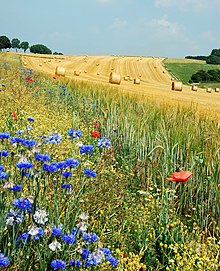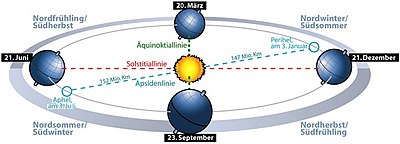summer
The Summer is the warmest of the four seasons in subtropical, temperate , cold and arctic climates . Depending on whether it is currently in the northern or southern hemisphere , one speaks of northern or southern summer . The northern summer takes place at the same time as the southern winter.
Emergence
The seasons arise because the earth's rotation does not take place in the plane of the orbit around the sun, but inclined by 23.4 ° (see ecliptic inclination ). As a result, the north and south poles lie alternately in the grazing sunlight for half a year, and the zenith of the sun changes in the annual cycle between the northern and southern tropics .
Duration
Astronomically, summer begins with the summer solstice - the point in time when the sun is vertically above the tropic of its own hemisphere and the days are the longest. The beginning of summer is
- in the northern hemisphere on June 20th , 21st or 22nd or
- in the southern hemisphere on December 21st or 22nd .
Then the days get shorter and the nights longer. The northern summer ends with the autumnal equinox on September 22nd or 23rd and the southern summer on March 20th or 21st .
In the East Asian cultural area, which is characterized by the Chinese calendar , summer begins when the sun is 45 ° before the solstice (May 5th, 6th or 7th) and ends when the sun is 45 ° behind it (7th May). , August 8 or 9). The solstice is in the middle of summer. This quarter corresponds exactly to the time when the sun is highest in the sky, i.e. has the potentially greatest radiance on the respective hemisphere.
Since the earth's orbit around the sun is slightly elliptical, i. H. deviates from an exact circular path by 1.7 percent, the four seasons are not exactly the same length. The northern summer is slightly longer than the southern summer because during the northern summer the earth is a little further away from the sun ( aphelion on July 5th) and its direction towards the sun changes a little more slowly.
The phenological beginning of summer can differ considerably from the astronomical one and is influenced not only by the land-sea distribution ( maritime vs. continental climate ) but also by general weather conditions and various regional factors. A distinction is also made between early summer , midsummer and late summer .
Meteorologically , the months of June , July and August are assigned to the northern summer , and the months of December , January and February to the southern summer .
In Central Europe, the potential peak of summer with the highest temperatures is around three to six weeks after the summer solstice, i.e. between mid-July and the end of July, a little earlier in a more continental climate and a little later in a more maritime climate.
The so-called polar day prevails in the geographic poles for half a year , while the arctic regions have weeks of midnight sun and white nights .
Culture
In many cultures, customs and rites with the beginning of summer are connected, in Germany for example the solstice or bonfires . Otherwise, summer is also the season of increased joie de vivre. This is especially true for stays and outdoor activities caused by the higher temperatures, e.g. B. in bathing lakes , as well as to hormones released by solar radiation .

